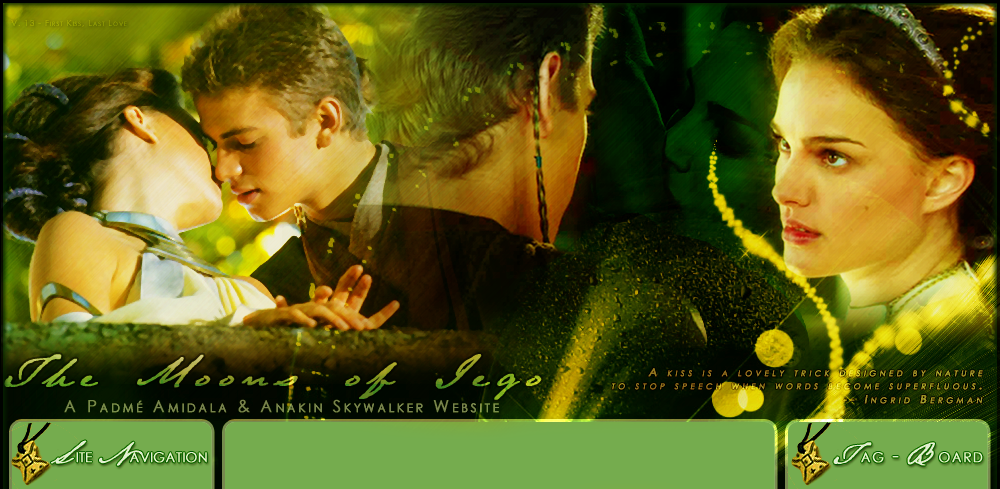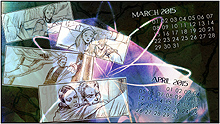



IMAGE |
WALLPAPER |
FAN ART |
FAN FICTION |
Rush by Love and Rock Music. (TCW) The first half of "Destroy Malevolence," as Anakin and Padmé make their way towards each other. |
P/A SITE
|
|
CALENDAR
|
 |

ESSAYS & DISCUSSION
-------------------------------------------
Love and War
by Paul F. McDonald
Published on Suite101.com July 16, 2002
------------------------------
"This love smites me so gently/ At heart and with such sweet savor!/ Of grief do I die one hundred times a day,/ And of joy revive, again a hundred." - Bernart de Ventadorn
The galaxy is already in turmoil when Attack of the Clones begins. Hundreds of star systems have seceded from the Republic, and the Separatist movement they have formed is threatening nothing less than full-scale war. Meanwhile, a clone army is being created without anyone's knowledge, bounty hunters are staging assassinations, and even the Jedi have found their ability to use the Force diminished. Set against the backdrop of what is clearly one of the pivotal epochs in the galaxy, two young people are torn between passion and duty, and their love will have massive ramifications for the Republic.
To be sure, this is not an easy romance to establish in this age of irony, and predictably, it has been one of the more criticized elements in the film. The relationship between Anakin Skywalker and Padmé Amidala is simply not compatible with most of the love stories that have dominated popular entertainment. It is best when viewed not against Sex in the City or even Titanic, but rather other tales that have a certain of mythic weight to them. When the first trailers debuted, I wrote an editorial for TheForce.net concerning the parallels between the Anakin and Padmé romance and the tradition of courtly love that came about in the Middle Ages. After seeing the film, this correlation is even stronger, for it gives fine expression to that particular manifestation of love in which it is tantamount to divine siezure.
There were many kinds of courtly love that sprung up all over Europe, from the "minnesingers" wandering the German countryside telling tales of love, to the troubadours traveling from court to court in the south of France reciting lyrics about unrequited hearts. However, this was no mere sentimentality confined to emotional fantasy. As Joseph Campbell writes in "Creative Mythology," it was a new way of feeling, a veritable religion of love. Neither driven by indiscriminate desire nor the dictates of church and state, it was "a flame of love in which lust and religion are equally consumed."
For the troubadours, this earth in all its pain was still their heaven. These are the days in which Dante had but one fleeting glance at Beatrice and yet fell in love with her instantly, and remained that way until his death. This is when the poet Gottfried van Strassburg was providing "bread for noble hearts" through the tragic tale of Tristan and Isolde. This is when the youthful affair of Heloise and Abelard ended in tragedy, yet after it was all over, her passion still had not dimmed as these words reflect - "God knows, but at your command, I would have followed or preceded you to fiery places. For my heart is not with me but with thee."
It is a rare thing today when young lovers challenge hell (or even have a hell by which to do so), but this is a fitting context for Anakin and Padmé. In the courtly tradition, even those who have found their way to the unmarked "grotto of love" the troubadours celebrated always faced the ordeal of the inevitable parting. Afterwards, many poems protested the watchmen, for he announced the coming of the dawn, when the sweet embrace of night faded into the reality of lovers separated by the daylight world of proper society. Yet this undeniably fueled many of the more poignant lyrics. Gottfried spoke of the "dear pain" and "bitter sweetness" of such an experience, and the inseparability of joy and agony will certainly continue to play out for Anakin and Padmé.
The themes of courtly love are forever a part of medieval literature, announcing themselves again and again in the tales of the age. Many of the old romances could go on for years without lovers even seeing one another, for there was almost always a situation that required them to be unrequited. Often, a knight would swear his allegiance to a certain lady, and she would sometimes be an older woman of high social standing. The ladies were often seen as somewhat of a civilizing force for young men, and as such, were usually in positions of authority over them. The knights would go out and perform valiant deeds in their names, sometimes winning a kiss, sometimes something more. In such a situation, the young men would be the ones to prostrate themselves before their beloved, whether literally in life or metaphorically in poetry. "Behold, I am at thy command," the troubadour Benart de Ventadorn once wrote, helpless against his lady and the "tyrant-goddess love."
Clearly, there are many parallels to be found with this in Attack of the Clones. Anakin is a Padawan learner sworn to the Jedi, even as his heart lies with Padmé. Under the authority of the Jedi Code, he has suffered through not seeing his beloved for ten years. Padmé is appropriately four years older than he is, and is a senator of prominence and prestige. Anakin swears himself to her at every given opportunity, and finally tells her, "I will do anything that you ask." This certainly carries shades of Ventadorn, as does the phrase "m'lady," which both Anakin and Obi-Wan use in deference to Padmé. The only break the film makes with courtly love is when Anakin and Padmé do marry in the end, for the old love existed almost exclusively outside the realm of marriage.
There has been much discussion about the dialogue during the fireside scene when Anakin really lets his feelings be known to Padmé. Some have found the words he speaks too lyrical, tipping the scale from the romantic to the cheesy. He tells her that he is "in agony" after the first kiss they shared, and that he "can't breathe" when he thinks he might not be with her. But when his feelings are properly set against the uncontrollable, illicit love the "minnesingers" celebrated, they become much more understandable. As Campbell once noted, "In courtly love, the man goes crazy, not the woman. When the man's been moved like this, he is capable of great feats, but he's on a narrow path." In Arthurian lore, both Sir Lancelot and Tristan went mad over love affairs, at least temporarily. When Anakin tells Padmé he hopes her kiss "won't become a scar," this is almost a direct reference to Tristan, who had the sickness only Isolde could cure.
It has been argued that Lancelot found an illumination in his forbidden affair with Queen Guinevere that even the Holy Grail could not provide, and the same might be said of Anakin in relation to the Force. It is not easy to dismiss the intensity of his feelings. For him, it is clearly love at first sight when he initially sees Padmé in Watto's junk shop on Tatooine. For him, Padmé is the life-revivifying waters of the Grail itself. This is not the kind of love that is easily relatable by the standards of today's media, mostly because they are still trapped in the twin conceptions of love that dominated the early Middle Ages. Campbell talked about these during "The Power of Myth" series, and they are likewise addressed in Attack of the Clones.
When they are traveling to Naboo as refugees, Padmé asks Anakin whether love is forbidden for a Jedi. He replies that while possession and attachment are forbidden, compassion is central to a Jedi's life. The first is really "eros," the love of lust, of wanting to physically possess someone, and the latter is "agape," the love of one's neighbor, the indiscriminate aspect of spiritual feeling. Neither of these work for the two. What has to brought about is a third possibility, the realization of "amor," the "flame of love" that Campbell noted consumed and supplemented the other two.
The climax of the relationship and the triumph of "amor" comes near the end of the film, when Anakin and Padmé are captured on Geonosis. Sentenced to public execution, the two have a short though fateful exchange before they are taken out to the arena to be slain. Both characters have been quite headstrong, and have decided not to privately consummate their relationship, afraid it might completely unravel their public lives. Yet when faced with annihilation, they finally surrender and give themselves to one another.
Anakin tells her not to be afraid to die, and Padmé replies that she's been dying a little bit each day since he came back into her life. Finally setting her political ideals aside, she tells him that she truly and deeply loves him, and that she wants him to know that before they die. The dialogue perfectly illustrates what's happening to them, as do the visuals. This close association of love and death is not by accident. Mythologically speaking, the willingness to love, to arrive at the place where two becomes one, requires nothing less than a death and resurrection.
The scene in the arena therefore becomes an initiation for Anakin and Padmé as they move to embrace the ordeal that is being in love. The blissful kiss they share comes to an end when they are separated and tied to poles where they are to be ripped to pieces by wild beasts. The symbolism should be obvious from a psychological point of view. One of Carl Jung's proteges, Joseph L. Henderson, wrote an essay called "Ancient Myths and Modern Man." In it, he spoke of many patients who had dreams that combined the "motif of sacrifice" with the "motif of the sacred marriage." Along these lines, Campbell likewise noted that before he was married, he felt as if he were about to be crucified. There is always a point at which young lovers must play the role of sacrificial victims - not only willingly, but joyfully.
Anakin and Padmé pledging themselves to each other before they are to be essentially dismembered and crucified is perhaps the finest representation the mythic rites of the "love-death" have had in centuries, a glorious affirmation of the agony of both life and love.
-
<<back to essays & discussion